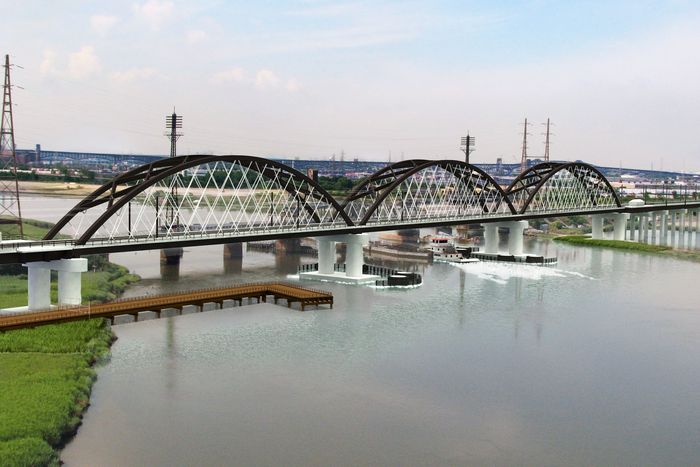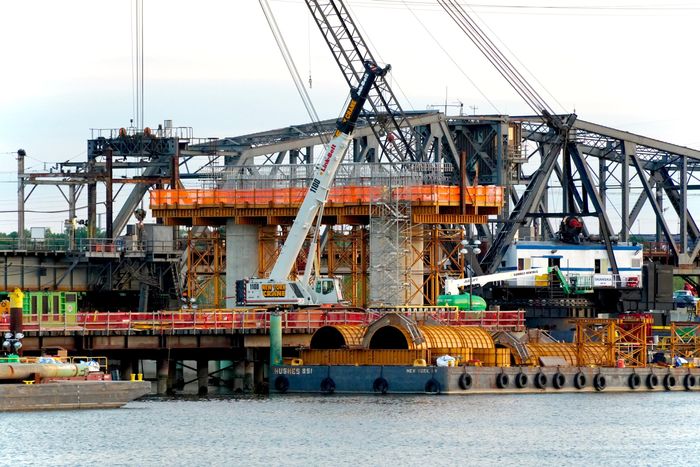The Unbuilt Bridge That’s Throttling Penn Station

The Portal Bridge: In addition to being replaced, it needs a twin.
Photo: Marc Glucksman/Amtrak
A transportation system is a link to a link to a link to a link. In the case of the Northeast Corridor rail line, it’s a choke point to a choke point to a choke point. The best-known one of those bottlenecks — the ancient, fragile tunnel under the Hudson that brings trains into Penn Station — is the focus of the Gateway Project, whereby the federal government, New York, and New Jersey are spending $16 billion to double the number of trains that can fit and improve their reliability. It is inarguably necessary, and it should have been built long ago. In fact, it nearly was.
But the number of trains that can reach those tunnels will be the same as it is currently, 24 per hour in each direction, unless we deal with a second choke point: a bridge, way out past Secaucus, that carries trains to the tubes. Right now, they go over the Portal Bridge, built in 1910, spottily maintained through its long life, and currently being replaced at a cost of $2.4 billion. Those dollars are well spent. The old bridge needs to swing open every time a ship passes and regularly gets stuck, jamming up the whole Northeast Corridor. The new Portal North Bridge will be higher, so it won’t have to open and close, and it also won’t be a century and a quarter old. But it has only two tracks, same as the old one, and thus will add no capacity.
What’s needed is a parallel span with two more tracks. It’s on the drawing board, known as the Portal South Bridge, and it is paired with a line extension, the Harrison Fourth Track. The bridge is completely unfunded — it would cost $2.5 billion, about as much as its northern partner — and the Harrison work is millions short. The $63 billion that “Amtrak Joe” Biden got into the infrastructure bill for passenger rail has all been allocated or spent, most of it on 50 years’ catchup work. Finding more money will require another act of Congress — and the forthcoming Congress will likely have at least one chamber controlled by Republicans, who have long been hostile to transit funding in general and Amtrak in particular. Getting this second span built then is going to require, in addition to electoral luck, a compelling case that’s been scrubbed and bulletproofed against the inevitable pushback.
A rendering of Portal North Bridge, which replaces but does not expand the capacity of its predecessor.
Photo: GDC
Governors Kathy Hochul and Phil Murphy and U.S. Secretary of Transportation Pete Buttigieg should be leading the charge to break this choke point as quickly and as cost-effectively as possible. They, however, are not exactly in charge of this project. Amtrak is, and the bureaucrats there, unchecked by effective oversight, are far more interested in empire building. What Amtrak is doing, instead, is renewing its quest for an immense expansion of Penn Station immediately to the south of the current hub at a cost of up to $16.7 billion. That expansion, known as Penn South, is also unfunded. Nonetheless, on October 1, Amtrak officials held a briefing in a conference room at Moynihan Train Hall, accompanied by a 200-page report declaring that it’s not possible to increase Penn Station’s capacity by improving its operations. Instead, the executive summary concludes: “A separate, future analysis will evaluate alternatives that expand the footprint of Penn Station.” In short: Here come the bulldozers.
Portal North Bridge (under construction), with the old Portal Bridge behind it.
Photo: George Wirt/Shutterstock
The amount of dissembling contained in those 14 words is extraordinary. The Penn South plan is not a ghost in the future. I’ve written about it. Amtrak has been trying to tee up this monstrous waste of money for years. It largely exists because the agency wants to spend an 11-figure sum and demolish a chunk of midtown largely to avoid making a peace deal and sharing with the MTA and New Jersey Transit. Amtrak’s own documents show plans to build Penn South as early as 2011 — well before this planning process got started. It explicitly states the reason for building a new station is to give each railroad at Penn Station — Amtrak, New Jersey Transit, and the Long Island Rail Road — its own “semi-independent” facilities. The price tag was, back then, expected to be about $6.5 billion, or $8.7 billion adjusting for recent inflation. In 2023, when the still-unreleased Penn Station Expansion Project feasibility report was completed, it laid out an even larger version of the project, expanded from eight tracks to either nine or 12, and hiked the budget as high as $16.7 billion. None of this information was included in what Amtrak released this month, suggesting that the only thing that may be in shorter supply than money for Portal South Bridge is the agency’s credibility.
At that briefing, one reporter asked what had happened to those studies, and a spokesman for Amtrak said: “What you’ve heard here today, basically, is that the options, the alternatives, and the concepts that we studied, none of them meet the criteria.” (The criteria, conveniently set by Amtrak, are designed to yield one outcome: Penn South.) Internal plans developed by the MTA and NJ Transit offer a real chance to improve the efficiency of the complex without building anew next door, potentially getting within spitting distance of the 48-train-per-hour target and doing it for approximately $10 billion less than this Amtrak Death Star would cost. Funding for the railroads is about to become a whole lot harder to get, and each dollar received is going to have to be squeezed as hard as possible to deliver maximum benefit. We’re drowning in car traffic and pollution, and every ton of carbon adds fuel to the climate-change crisis. Every dollar that goes to one project cannot go to another. We need the second span, and a cheaper Penn Station plan can only help make that happen.
Source link






